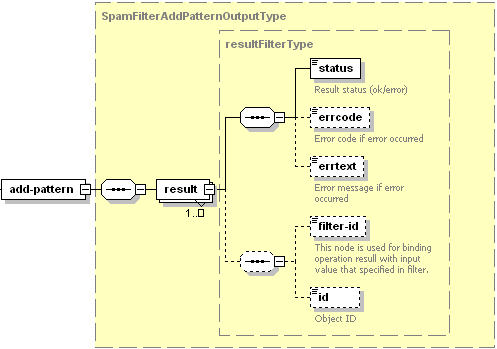Adding Pattern
Use the add-pattern operation to add new patterns to a specified list of a specified user (Administrator or mailbox owner). For information on patterns refer to the Defining Pattern section.
Request Packet Structure
A request XML packet adding a pattern includes the add-pattern operation node:
<packet>
<spamfilter>
<add-pattern>
...
</add-pattern>
</spamfilter>
</packet>
The add-pattern node is presented by the
SpamFilterAddPatternInputType type (spamfilter.xsd), and its
graphical representation is as follows:

Note: The interactive schema navigator for all request packets is available here: http://plesk.github.io/api-schemas/1.6.8.0/agent_input.svg.
- The filter node is required. It specifies the filtering rule.
Data type: SpamPatternFilter (
spamfilter.xsd). - The list node is required. It specifies the type of the list.
For information on list types, refer to the Types of Server
Lists and Types of Lists available for Mailbox
Owners sections. Data type: SpamListType
(
spamfilter.xsd). Allowed values: black | white | unblack | unwhite. - The username node is required.It specifies the name of a SpamAssassin user. You can specify e-mail address of a mailbox owner, or the ‘admin’ value. To access server black (white) lists, you should set ‘admin’ as a value for this node. Data type: string.
- The spamfilter-id node is required. It specifies the ID of a SpamAssassin user. Data type: integer.
Remarks
You can add patterns to multiple users in a single packet. Add as many add-pattern operations as the number of different users to be affected.
<add-pattern>
...
</add-pattern>
...
<add-pattern>
...
</add-pattern>
Note: When creating request packets, put nodes and elements in the order they follow in the packet structure.
Response Packet Structure
The add-pattern node of the output XML packet is presented by type
SpamFilterAddPatternOutputType (spamfilter.xsd) and structured as
follows:

Note: The interactive schema navigator for all response packets is available here: http://plesk.github.io/api-schemas/1.6.8.0/agent_output.svg.
- The result node is required. It wraps the response retrieved
from the server. Data type: ResultFilterType (
common.xsd). - The status node is required. It specifies the execution status of the add-pattern operation. Data type: string. Allowed values: ok | error.
- The errcode node is optional. Is returns the error code if the add-pattern operation fails. Data type: integer.
- The errtext node is optional. It returns the error message if the add-pattern operation fails. Data type: string.
- The filter-id node is optional. It holds the filtering rule parameter. For information, refer to the Available Filters section. Data type: anySimple.
- The id node is optional. It returns the ID of the added pattern if the operation succeeds. Data type: integer.
Samples
Adding a pattern
This request packet adds pattern *@spam.net to the server black list.
<packet>
<spamfilter>
<add-pattern>
<filter>
<pattern>*@spam.net</pattern>
</filter>
<list>black</list>
<username>admin</username>
</add-pattern>
</spamfilter>
</packet>
Response:
<packet>
<spamfilter>
<add-pattern>
<result>
<status>ok</status>
<filter-id>*@spam.net</filter-id>
<id>17</id>
</result>
</add-pattern>
</spamfilter>
</packet>
If the SpamAssassin service is restricted by Plesk license key, or a user does not have access to SpamAssassin management, the response is as follows:
<packet>
<spamfilter>
<add-pattern>
<result>
<status>error</status>
<errcode>1006</errcode>
<errtext>Permission denied.</errtext>
<filter-id>*@spam.net</filter-id>
</result>
</add-pattern>
</spamfilter>
</packet>
Adding multiple patterns
This request packet adds patterns *@spam.net and spam@mailme.net to the black list of mailbox mybox@site.com.
<packet>
<spamfilter>
<add-pattern>
<filter>
<pattern>*@spam.net</pattern>
<pattern>spam@mailme.net</pattern>
</filter>
<list>black</list>
<username>mybox@site.com</username>
</add-pattern>
</spamfilter>
</packet>
Response (if the pattern *@spam.net is already present in the black list of the mailbox owner, the response can look as follows):
<packet>
<spamfilter>
<add-pattern>
<result>
<status>error</status>
<errcode>1007</errcode>
<errtext>The inserted data already exists.</errtext>
<filter-id>*@spam.net</filter-id>
</result>
<result>
<status>ok</status>
<filter-id>spam@mailme.net</filter-id>
<id>15</id>
</result>
</add-pattern>
</spamfilter>
</packet>